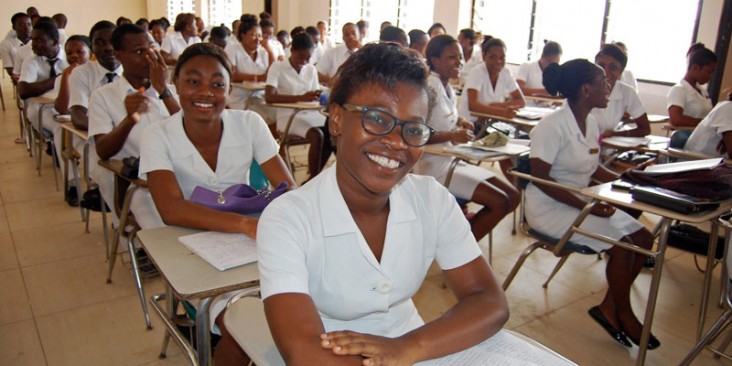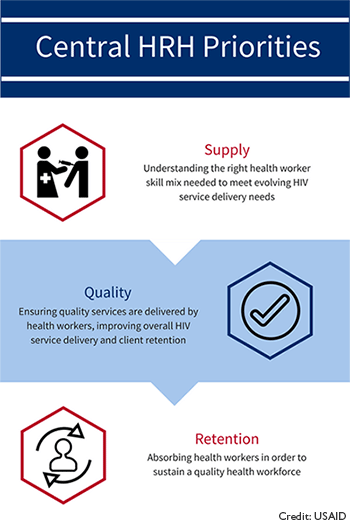- What We Do
- Agriculture and Food Security
- Democracy, Human Rights and Governance
- Economic Growth and Trade
- Education
- Ending Extreme Poverty
- Environment and Global Climate Change
- Gender Equality and Women's Empowerment
- Global Health
- Water and Sanitation
- Working in Crises and Conflict
- U.S. Global Development Lab

Overview

To achieve an AIDS-free generation, the U.S. Agency for International Development (USAID) seeks to ensure adequate supply, quality and retention of human resources for health (HRH) to expand HIV and AIDS services to those most in need.
In an effort to expand HIV coverage, UNAIDS issued the 90-90-90 treatment targets, which USAID utilizes the “Test and Start” approach to help meet. Implementation of “Test and Start” and corresponding differentiated service delivery models place greater demands on a country’s health workforce that raise new areas of focus and consideration for HRH. New global HRH priorities from the WHO Global Strategy on Human Resources for Health [PDF, 368KB] and the final report from the High-level Commission on Health Employment and Economic Growth recognize HRH as a triple return on investment for health, economic growth and health security. USAID has been at the forefront of aligning with new global priorities to ensure that HRH activities are the most innovative, strategic and sustainable.
Current HRH programmatic efforts are focused on:
- Increasing availability and utilization of data for HRH decision-making
- Optimizing HRH for HIV service delivery models
- Expanding and sustaining the role of the community-based health workforce
- Innovative financing for HRH
Increasing Availability and Use of HRH Data
HRH data is vital to answering critical questions related to supply, quality and retention of the health workforce. Limited HRH data across countries impedes USAID’s ability to assess needs and programmatic impact. To identify immediate HRH needs to achieve the 90-90-90 targets, USAID is supporting rapid, site-level HRH assessments using a tool developed in collaboration with other U.S. President’s Emergency Plan for AIDS Relief (PEPFAR) implementing agencies. Data from assessments conducted across 210 sites in Malawi and Zambia are being used to inform implementation of “Test and Start” and differentiated service delivery models. USAID is also working to advance better understanding of country HRH labor markets through instruments such as the WHO National Health Workforce Accounts [PDF, 3.4MB] so that countries can conduct more comprehensive health workforce planning and better align HRH investments to the areas of greatest need and available resources in country.
Optimizing HRH for HIV Service Delivery Models
Differentiated service delivery models are key to the successful implementation of “Test and Start.” Each model utilized requires consideration of the health workers required, roles, responsibilities and factors to ensure performance and productivity. USAID is working to ensure that countries have adequate information for decision-making on how health workers are being optimally utilized across facilities and communities. USAID also strives to build capacity to support health worker performance and productivity for quality HIV service delivery.
Expanding and Sustaining Community-based Health Workers
Community-based health workers have been critical to the expansion and successes of HIV programs. There is a diversity of workers at the community level that provide patient support, connect community members to health facilities and play an active role in expanding prevention services, diagnosis and antiretroviral therapy coverage to meet the 90-90-90 goals. USAID is working to build country-level coordination and partnerships to strengthen the accountability, effectiveness and sustainability of the role of community-based health workers for HIV programs.
Increasing HRH Financing for HIV Service Delivery
Diversifying country financing for HRH is critical for the sustainability of a quality health workforce for HIV. In alignment with health financing investments and the Sustainable Financing Initiative, USAID is working with PEPFAR countries to build a stronger case for mobilizing domestic resources to invest in HRH. Making the case for increasing HRH financing ensures absorption and retention of the health workforce needed to support HIV service delivery.







Comment
Make a general inquiry or suggest an improvement.